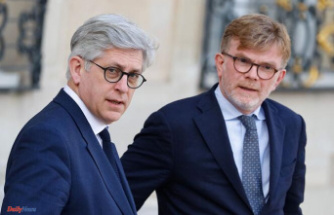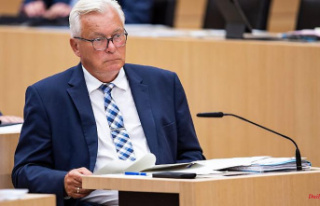Due to the sharp increase in the cost of real estate loans, building or buying a house has also become significantly more expensive. But now, according to financial advisors, there are at least signs of a pause in interest rates. Behind this are economic concerns - they are slowing down the rise in interest rates.
After the rapid increase in interest rates, experts see a breathing space for builders and real estate buyers. After a recent downward trend, they expect construction interest rates to rise relatively little or move sideways by the end of the year. Even before the European Central Bank's key interest rate hike, the interest rates for ten-year construction loans had fallen noticeably, observed the Munich-based credit broker Interhyp. They were most recently at around 3 percent after a good 3.4 percent at the top.
"At the moment the trend in construction interest is falling," said Max Herbst, founder of FMH financial advice. There is a short-term dip, the uptrend is broken. Most recently, Herbst still thought building rates of 4 percent possible after the summer break. After building interest rates have more than tripled from 0.8 percent to over 3 percent since January, Interhyp now expects less momentum.
"The banks have already largely factored in expectations of the planned rate hikes, and concerns about the economy are becoming increasingly important," explains Mirjam Mohr, director of retail banking at Interhyp. That slows down the rise in interest rates. The signs are now set for a tighter monetary policy. Interhyp expects a moderate increase in construction interest rates to 3.5 to 4 percent for ten-year loans by the end of the year.
Ditmar Rompf, CEO of the construction financier Hüttig, is more reserved
The reason for the rise in construction interest rates since the beginning of the year was the high level of inflation, which is putting central banks under pressure to raise interest rates. The ECB has also announced further rate hikes. In anticipation of a tighter monetary policy, the yields on ten-year government bonds, which are used as a basis for construction interest, shot up. Recently, however, yields have fallen sharply.
The rise in interest rates since January means immense burdens for debtors. The comparison portal Check24 recently calculated that construction financing of more than 400,000 euros at an effective interest rate of 3 percent results in almost 79,000 euros in additional costs over ten years. Pekka Sagner, real estate expert at the German Economic Institute (IW), expects interest rates to plateau. Recently there have been clear exaggerations, he says.
Sagner believes that if further interest rate hikes by the ECB trigger concerns about a payment crisis in highly indebted countries like Italy, building interest rates could fall further. "The idea that rising key interest rates automatically mean higher building interest rates is deceptive." Concerns about a new debt crisis in Southern Europe could make Bunds more attractive for investors. That would drive up their prices and, in return, depress the yields on federal bonds - and thus the interest rates on construction projects.
The ECB has already announced that it will intervene by buying bonds if necessary, should interest rates on securities from euro countries rise disproportionately. FMH expert Herbst also believes that the situation in Italy with the recent government crisis can lead to investors increasingly looking for security in federal bonds. However, property owners should not rely on lower building interest rates. The situation is too fragile for that.












